Abstract
Photoionization is a significant factor influencing the morphology and propagation characteristics of streamers in insulating oil, yet research on the impact of photoionization on streamer branching is almost nonexistent. In this study, we employed an ultraviolet absorber to regulate the photoionization behavior of streamer discharges in rapeseed insulating oil. A quantitative assessment was conducted on the propagation morphology, length, and temperature distribution of positive and negative streamers. The results indicated that the streamer branches propagated in a dendritic manner. When photoionization was suppressed by the ultraviolet absorber, the streamer tended to generate more radially propagating branches, thereby shortening the axial stop length of the streamer branches by 1~3 mm. In addition, suppressing photoionization caused the maximum temperature to rise by approximately 74~220 K, generating more high-temperature hot spots within the streamer branches and promoting the formation of more radially propagating branches in the streamer. The analysis results demonstrated that suppressing photoionization weakened the axial electric field strength in the head region of the streamer branches, thereby inhibiting the electron avalanche behavior at the head of the streamer and thus reducing the rate of axial propagation of the streamer branches.
1. Introduction
Mineral insulating oil has been widely used in oil-filled power equipment such as transformers, capacitors, and cables for over a century. Due to the presence of non-environmentally friendly components, such as straight-chain alkanes, branched alkanes, and cycloalkanes, as well as highly carcinogenic additives in mineral insulating oil, and because its biodegradation rate is less than 30% in 28 days, leakage incidents from power equipment using mineral oil can severely contaminate the surrounding environment [1,2]. Natural ester insulating oil, as a potential substitute for mineral insulating oil, meets the quality requirements for insulating oil in ordinary power equipment in terms of its physical, chemical, and electrical properties. The biodegradation rate of natural ester insulating oil exceeds 95% in 28 days, and it also has advantages such as a high flash point, high sound absorption coefficient, and high dielectric constant, and it extends the service life of insulating paper [3,4,5,6]. Furthermore, it has been well promoted and applied in distribution transformers. However, the impulse breakdown strength of natural ester insulating oil under uneven electric fields and long oil gaps is significantly lower than that of mineral insulating oil. Its use in large power equipment [7,8,9] with complex electric field distribution and high local field strength may result in streamer discharge and breakdown faults, which are not conducive to the large-scale promotion and application of natural ester insulating oil in power equipment. Studying the streamer discharge of natural ester insulating oil under uneven electric fields can not only deepen our understanding of the impulse breakdown mechanism of natural ester insulating oil but also provide theoretical guidance for the technology to improve the insulating performance of natural ester insulating oil.
The shadow method and the direct shooting method are the two main methods used to obtain streamer discharge images. The former images the streamer branching channel, while the latter images the streamer luminescent channel. X. Lin et al. [10] systematically studied the morphological characteristics of streamer discharge in natural ester insulating oil and mineral insulating oil under extremely uneven electric fields and lightning impulse voltages using the shadow method. They found that the streamer branches in natural ester insulating oil were sparser and more slender than those in mineral insulating oil. Specifically, the streamer branches in natural ester insulating oil were more likely to develop forward along the needle-plate electrode axis, while the streamer branches in mineral insulating oil mainly developed forward in a random divergent manner. Closely related to this propagation mode was that under a 50 mm oil gap, when an externally applied positive voltage reached the breakdown voltage of natural ester insulating oil, there was a high probability that the streamer in natural ester insulating oil transitioned from the second propagation mode (1~5 km/s, commonly known as slow streamer) to the third propagation mode (10~100 km/s, commonly known as fast streamer). Streamers in mineral insulating oil needed to be under externally applied voltage higher than the acceleration voltage to possibly develop forward in the third mode. It can be seen that the slender and easy-to-develop streamer branch morphology in natural ester insulating oil is an important reason for the lower breakdown voltage of natural ester insulating oil under long oil gap conditions. Therefore, studying the influencing factors of the streamer branch morphology and rapid axial propagation in natural ester insulating oil is crucial for improving the insulating performance of natural ester insulating oil.
Many scholars have conducted a lot of experimental research on the influencing factors of streamer discharge in insulating oil, including voltage, additives, and static pressure [11,12,13]. S. Ingebrigtsen et al. [14,15] found that low ionization energy additives enhanced the ionization degree of streamers, reduced the starting voltage of streamers, and thus promoted the rapid propagation of positive streamers; electron adsorbents made the head region of negative streamers adsorb more electrons, further enhancing the electric field distortion of the head region of negative streamers and thereby promoting the propagation of negative streamers. Both types of additives made the streamer branches of the corresponding polarity thinner and increasingly developed. K. Wang et al. [16] studied the contribution of oxygen atoms to the frontier orbitals of natural ester insulating oil molecules through simulation modeling methods. They found that in the process of negative streamer discharge, natural ester insulating oil molecules were more likely to produce oxygen-containing free radicals that strongly adsorb electrons and thus became an important factor promoting the rapid propagation of negative streamers in natural ester insulating oil. The above research results showed that the morphology and propagation characteristics of streamer branches in natural ester insulating oil were closely related to ionization and the internal charge characteristics of streamers.
The internal charge of the streamer channel in insulating oil is mainly produced by field ionization, collision ionization, and photoionization. Among these, field ionization and photoionization can directly ionize molecules in a strong electric field and in an environment containing high-energy ultraviolet (UV) light, respectively, while collision ionization requires a large displacement to complete electron acceleration; therefore, it takes a long time to produce a charge through collision ionization. Some studies show that both field ionization and photoionization promote the rapid propagation of streamers. However, A. Sun et al. [17] found, through simulation, that under the condition of a microsecond pulse discharge, it is difficult for most areas of the streamer channel to undergo field ionization, and only the head area of the streamer may undergo field ionization, leading them to believe that field ionization is a secondary influencing factor in the process of streamer propagation. I. Madshaven [18,19] established a photoionization model of streamer discharge, and his simulation results show that photoionization is an important reason for the transition from slow streamer to fast streamer. S. Liang [20] significantly improved the positive breakdown voltage and acceleration voltage of natural ester insulating oil (FR3) by adding a UV absorber. Obviously, photoionization is an important factor affecting the morphology and propagation characteristics of streamer discharge branches in natural ester insulating oil, but research on the influence of photoionization on streamer branches is almost nonexistent, which hinders a deep understanding and the proposal of effective methods to improve the insulation strength of natural ester insulating oil.
This paper conducts a comparative analysis to study the evolution of the morphology and temperature distribution of streamer branches in rapeseed insulating oil with added UV absorber in order to systematically analyze the influence mechanism of photoionization on the propagation of streamer branches.
2. Materials and Methods
The natural ester insulating oil used in this study was rapeseed oil. A comparison of its physicochemical parameters with those of other commercial oils is presented in Table 1. The ionization energy and absorption spectrum parameters of UV absorber are crucial for regulating the photoionization of streamer discharge in natural ester insulating oil. When selecting UV absorber, the following principles should be adhered to: first, UV absorber should not become the main ionizing substances in streamer discharge. If the ionization energy of the UV absorber is lower than or equal to the ionization energy of the molecules of natural ester insulating oil, then the UV absorber has a high probability of becoming the main component of collision ionization or field ionization during the process of streamer discharge, which would undermine the inhibitory effect of the UV absorber on photoionization. Therefore, the ionization energy of the UV absorber should be higher than that of the molecules of natural ester insulating oil. Second, UV absorber should have good absorption capacity for UV light to effectively weaken the photoionization in streamer discharge. The ionization energy of the UV-1 molecule (7.528 eV) is higher than that of the primary ionizing substance in rapeseed insulating oil (triolein molecules, 7.223 eV). Additionally, the UV-1 molecule exhibits better stability compared to other inhibitors and has strong ultraviolet absorption capabilities.

Table 1.
Physicochemical parameter comparisons of rapeseed oil and commercial insulating oil.
In this paper, UV-1 (N-(ethoxycarbonylphenyl)-N′-methyl-N′-phenylformamidine) was selected as the UV absorber, with an ionization energy of 7.528 eV, which is 4.22% higher than the ionization energy of the main ionizing substance in streamer discharge in rapeseed insulating oil (glycerol trioleate molecule) of 7.223 eV. UV-1 was diluted to 0.01‰ in anhydrous ethanol, and its absorption spectrum was obtained using a spectrophotometer, as shown in Figure 1; the absorption spectrum of natural ester insulating oil (rapeseed insulating oil) is for the undiluted sample. Obviously, UV-1 absorbs UV light in the 272~345 nm band more strongly than in other bands, and the maximum absorption value of UV-1 diluted to 0.01 wt.‰ can reach 1.16. Rapeseed insulating oil also has good absorption capacity for UV light. The absorption spectrum of undiluted rapeseed insulating oil shows local peaks in the 252~257 nm and 389~394 nm bands, which are 4.29 and 4.12, respectively. Considering that UV-1 has been diluted to 0.01 wt.‰, the absorption capacity of UV-1 for UV light is far superior to that of rapeseed insulating oil.
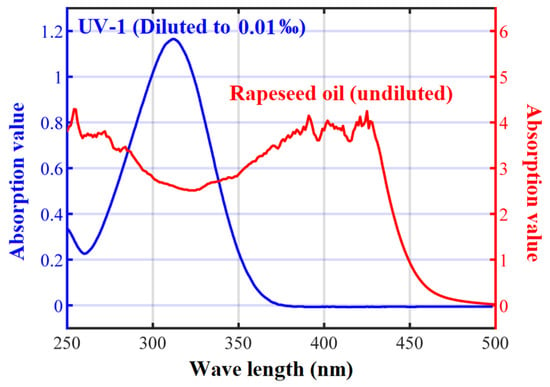
Figure 1.
Absorption spectrum of UV absorber UV-1 and rapeseed insulating oil.
Figure 2 shows the shadow imaging observation system for streamer discharge in oil, constructed by the research group. This system mainly consists of an impulse voltage unit, a light source unit, and a synchronous imaging unit. The impulse voltage unit contains an impulse voltage generator, which provides a standard lightning impulse voltage (1.2 ± 30%/50 ± 20% μs) for this experiment. The light source unit contains a parallel light source and a Lambertian diffuse light source. Both light sources are driven by a constant current circuit and a constant current power supply, providing stable and flicker-free illumination. The synchronous imaging unit includes a discharge oil tank, a broadband pulse current sensor (Pearson 6585, Pearson Electronics, Palo Alto, CA, USA), a UPS power supply, an oscilloscope (LeCroy WaveRunner 9000, LeCroy, New York, NY, USA), a high-speed camera (FASTCAM SA5, Photron Co., Tokyo, Japan), an ultra-high-speed ICCD framing camera (XXRapidFrame, Stanford Computer Optics Inc., Stanford, CA, USA), and a control computer, among other equipment. The current sensor can measure pulse currents with a rise time greater than 1.5 ns, and the measurement frequency band is 400 Hz~250 MHz. The oscilloscope has a maximum sampling rate of 40 GS/s and can record detailed voltage and current data. The high-speed camera has a maximum frame rate of 1 million frames per second. The ultra-high-speed framing camera uses a prism spectroscopic structure and contains four Quik E-dig cameras. It has a good sensitivity level for light in the 200~700 nm band. This camera has a minimum exposure time of 1.2 ns and can continuously shoot eight images. During the shadow imaging process, the high-speed camera is paired with the parallel light source, and the ultra-high-speed ICCD camera is used in conjunction with the Lambertian diffuse light source, effectively enhancing the imaging performance of the camera. All cameras are triggered to take synchronized photos by the single pulse signal output from the oscilloscope. This paper uses both the shadow method and the direct shooting method to obtain image data of streamer discharge under a 25 mm oil gap.

Figure 2.
Shadow imaging observation system of streamer discharge in insulating oil.
3. Results and Discussion
To analyze the influence of photoionization on the propagation and morphology of streamer branches in natural ester insulating oil, this paper uses a high-speed camera to capture the dynamic process of streamer branches in rapeseed insulating oil, as shown in Figure 3. In Figure 3a, no UV absorber is added to the rapeseed insulating oil, while in Figure 3b, 5% UV-1 is added to the rapeseed insulating oil to suppress the influence of photoionization on streamer discharge. The peak values of the lightning impulse voltage applied in the two figures are 53.06 kV and 53.32 kV, respectively, to avoid penetrating oil gap breakdown, on the one hand, and to compare the propagation and morphology of streamers on the other hand. Obviously, under similar voltage conditions, the axial stop length of the streamer in the insulating oil without added UV absorber is 14.49 mm, which is 2.41 mm higher than the axial stop length (12.08 mm) of the streamer in the insulating oil containing 5% UV-1, indicating that photoionization has a significant promoting effect on the propagation of positive streamers. In addition, the streamer branches in the insulating oil without added UV absorber tend to develop along the axis of the needle-plate electrode, while the streamer branches in the insulating oil containing 5% UV-1 tend to develop radially along the needle-plate electrode, indicating that photoionization can regulate the behavior of streamer branches developing along the axis or radially. This is consistent with the phenomenon in Figure 4 where the luminescent channel of the positive streamer propagates along the axis in an approximately straight line. Since the photoionization area is closely related to the luminescent channel, the luminescent channel along the axis of the needle-plate electrode will induce a higher photoionization effect in this direction, generate spatial charges distributed along the axis, and distort the electric field at the front end of the streamer branch, thus promoting the rapid propagation of the positive streamer branch along the axis.
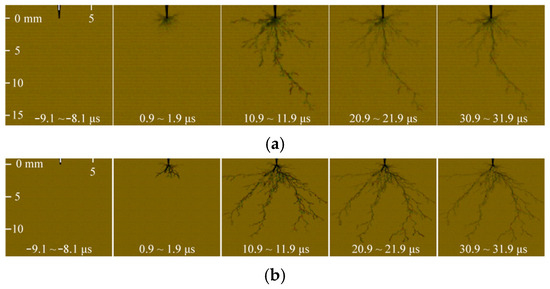
Figure 3.
Propagation of positive streamer branches in rapeseed insulating oil without UV absorber and rapeseed insulating oil with 5% UV-1. (a) Rapeseed insulating oil without added UV absorber (peak voltage 53.06 kV). (b) Rapeseed insulating oil with 5% UV-1 added (peak voltage 53.32 kV).
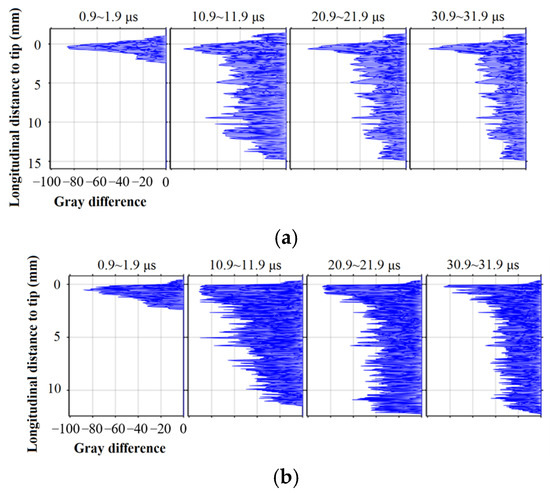
Figure 4.
Axial projection of the grayscale difference between the positive streamer and the background light along the needle-plate electrodes. (a) Rapeseed insulating oil without added UV absorber. (b) Rapeseed insulating oil with 5% UV-1 added.
In order to intuitively compare the changes in streamer grayscale over time by first eliminating the interference of background light, this paper subtracts the background image grayscale from the streamer image grayscale to obtain the grayscale difference between the streamer and the background, and projects the grayscale difference along the axis of the needle-plate electrode, as shown in Figure 4. The smaller the grayscale difference in the figure, the smaller the absolute value of the streamer grayscale, and the darker the color of the streamer; conversely, the larger the streamer grayscale, the lighter the color. The distribution of grayscale differences in the figure shows that the grayscale of the streamer in rapeseed insulating oil gradually decreases during 0.9~1.9 μs and 10.9~11.9 μs. The minimum grayscale differences in the insulating oil without added UV absorber are 86.65 and −89.36, respectively, while the grayscale differences in the insulating oil with 5% UV-1 added are smaller, at −88.31 and −91.46, respectively. Subsequently, during 20.9~21.9 μs and 30.9~31.9 μs, the grayscale of the streamer in rapeseed insulating oil gradually increases. At this time, the overall grayscale difference in the streamer in the insulating oil without added UV absorber is still higher than that in the insulating oil with 5% UV-1 added, with the minimum values being −85.64, −84.76, 87.73, and 85.81, respectively. This indicates that photoionization has the effect of increasing the grayscale of the streamer, while suppressing photoionization reduces the grayscale of the streamer. In addition, the blue lines depicting the grayscale difference in Figure 4a are generally sparser than those in Figure 4b. This is mainly because photoionization promotes the rapid propagation of streamer branches along the axis, so the number of streamer branches developing radially in rapeseed insulating oil without added UV absorber is generally less than that in rapeseed insulating oil with 5% UV-1 added. Therefore, the streamer branches in rapeseed insulating oil with 5% UV-1 added appear densely clustered.
Figure 5a,b, respectively, show the propagation process of negative streamers in rapeseed insulating oil without added UV absorber and with 5% UV-1 added. The peak voltages of the two figures are −76.38 kV and −76.94 kV, respectively, neither of which can cause oil gap breakdown. The streamer propagation images show that under similar voltage conditions, the axial stop length of the negative streamer in rapeseed insulating oil without added UV absorber reaches 15.64 mm, which is 1.32 mm longer than the axial stop length (14.32 mm) of the negative streamer in rapeseed insulating oil with 5% UV-1 added. This further confirms the significant promoting effect of photoionization on the propagation of negative streamer branches.

Figure 5.
Propagation of negative streamer branches in rapeseed insulating oil without UV absorber and rapeseed insulating oil with 5% UV-1. (a) Rapeseed insulating oil without added UV absorber (peak voltage −76.38 kV). (b) Rapeseed insulating oil with 5% UV-1 added (peak voltage −76.94 kV).
The grayscale differences in negative streamers projected along the needle-plate electrode axis in rapeseed insulating oil without added UV absorber and with 5% UV-1 added are shown in Figure 6. From the distribution of grayscale differences in the figure, it can be seen that during 0.7~1.7 μs and 10.7~11.7 μs, the grayscale difference in negative streamers generally shows a gradually decreasing trend. Among them, the minimum grayscale differences in the streamer in rapeseed insulating oil without added UV absorber are −92.15 and 96.22, respectively, both larger than the minimum grayscale differences in the streamer in rapeseed insulating oil with 5% UV-1 added (−93.01 and −97.38) during the corresponding periods. Subsequently, during 20.7~21.7 μs, the grayscale difference in negative streamers begins to gradually increase in the stem and middle regions, while it continues to decrease in the head region. At this time, the minimum grayscale difference in the streamer in rapeseed insulating oil without added UV absorber is −95.29, still slightly larger than the minimum grayscale difference in the negative streamer in rapeseed insulating oil with 5% UV-1 added (95.74). Finally, during the periods of 30.7~31.7 μs and 40.7~41.7 μs, the grayscale difference in the streamer begins to increase overall. At this time, the minimum grayscale differences in the streamer in rapeseed insulating oil without added UV absorber are −88.67 and −74.31, respectively, higher than the minimum grayscale differences in the negative streamer in rapeseed insulating oil with 5% UV-1 added (−89.05 and 75.82). Notably, the blue lines representing the grayscale difference in Figure 6b are denser than those in Figure 6a, indicating that suppressing photoionization is beneficial for the radial propagation of negative streamers.
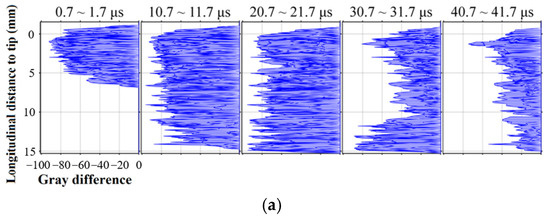
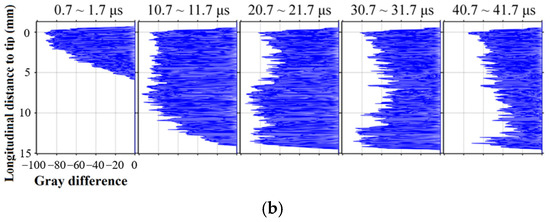
Figure 6.
Axial projection of the grayscale difference between the negative streamer and the background light along the needle-plate electrodes. (a) Rapeseed insulating oil without added UV absorber. (b) Rapeseed insulating oil with 5% UV-1 added.
In reference to Figure 3, which shows the positive streamer branches in rapeseed insulating oil without added UV absorber and with 5% UV-1 added, this paper uses the numerical analysis method of streamer image established by the research group to estimate their temperature distribution, as shown in Figure 7 [21]. The results in the figure indicate that during the period of 0.9~31.9 μs, the overall temperature of the positive streamer increases continuously as the streamer develops forward and then decreases as the streamer tends to dissipate. In addition, the maximum temperature of the streamer in rapeseed insulating oil with 5% UV-1 added (1196.12 K) is 220.07 K higher than the peak temperature of the streamer in rapeseed insulating oil without added UV absorber (976.05 K). It should be noted that the temperature of most areas of the streamer in rapeseed insulating oil with 5% UV-1 added is higher than the corresponding values in the insulating oil without added UV absorber, and it contains more local hot spots. This indicates that after the suppression of photoionization, the temperature of the positive streamer branches tends to increase, which is associated with the influence of photoionization on the grayscale difference in the streamer.
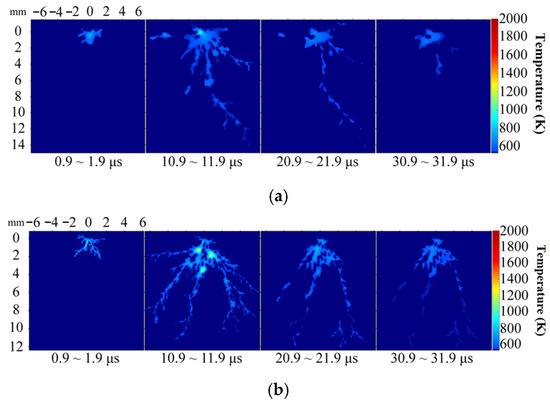
Figure 7.
Temperature distribution of positive streamers in rapeseed insulating oil. (a) Rapeseed insulating oil without added UV absorber. (b) Rapeseed insulating oil with 5% UV-1 added.
This paper also estimates the temperature distribution of the negative streamer branch channels in Figure 5, as shown in Figure 8. In which, Figure 8a is reprinted with permission from Ref. [21]. During the period of 0.7~11.7 μs, the temperature of the negative streamer continuously increases. The maximum temperatures of the negative streamers in rapeseed insulating oil without added UV absorber and with 5% UV-1 added are 2327.09 K and 2401.62 K, respectively. Subsequently, during 20.7~21.7 μs, the temperature of the upper-half region (axial 0~6 mm) of the negative streamer begins to decrease, while the temperature of the head region of the streamer continues to rise. The maximum temperatures of the negative streamer in rapeseed insulating oil without added UV absorber and with 5% UV-1 added reach 1406.01 K and 1479.32 K, respectively. Then, during the period of 30.7~31.7 μs, the temperature of the negative streamer shows a general downward trend. The maximum temperatures of the negative streamer in rapeseed insulating oil without added UV absorber and with 5% UV-1 added are 935.34 K and 955.16 K, respectively. Overall, the negative streamer in rapeseed insulating oil with 5% UV-1 added contains more local hot spots, and its temperature is higher than that of the negative streamer in rapeseed insulating oil without added UV absorber, with a maximum temperature difference of 74.53 K. This indicates that suppressing photoionization can also increase the temperature of the negative streamer. Compared with the positive streamer, its temperature rise amplitude is relatively weak.
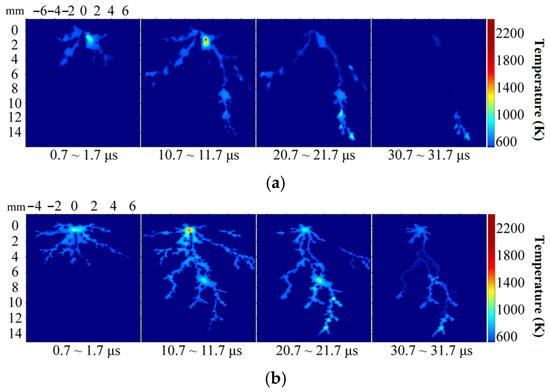
Figure 8.
Temperature distribution of negative streamers in rapeseed insulating oil. (a) Rapeseed insulating oil without added UV absorber. (b) Rapeseed insulating oil with 5% UV-1 added.
Figure 9 shows the changes in the positive and negative lightning impulse breakdown voltages of rapeseed insulating oil measured according to the IEC60897 standard [22] with the content of UV-1. From the breakdown voltage data, it can be seen that when no UV absorber is added, the positive and negative lightning impulse breakdown voltages of rapeseed insulating oil are 58.3 kV and −88.5 kV, respectively. When the content of UV-1 is 2%, the positive and negative lightning impulse breakdown voltages are increased to 61.79 kV and −88.94 kV, respectively, with an increase of 6% and 0.5%, respectively. The effect of UV-1 on the increase in the positive lightning impulse breakdown voltage of rapeseed insulating oil is better than that of the negative lightning impulse breakdown voltage. When the content of UV-1 is further increased to 5%, the positive lightning impulse breakdown voltage increases to 63.55 kV, with an increase of up to 9%.
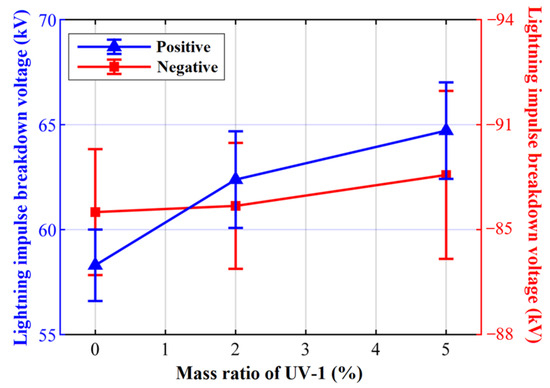
Figure 9.
Variation of lightning impulse breakdown voltage of rapeseed insulating oil with the content of UV-1.
The necessary condition for direct photoionization is that the insulating oil molecules can absorb UV light with energy higher than their ionization energy. The UV light in the streamer is mainly produced by the recombination of electrons and positive ions. However, the electrons involved in the recombination usually first form negative ions and then recombine with positive ions. Negative ions will absorb some energy during the recombination process, and the UV light energy released by the positive and negative ions due to recombination is usually slightly lower than the ionization energy of the insulating oil molecules. Therefore, streamer photoionization should occur in a graded ionization mode. Since negative ions in the streamer channel are extremely unstable, they will decompose again into electrons and molecules. Compared with the duration of lightning impulse voltage of 10~50 μs, the adsorption time of negative ions to electrons is shorter, about 0.1~0.2 ns [23]. Therefore, it can be reasonably assumed that the charge in the streamer channel mainly contains electrons and positive ions.
Figure 10a is a schematic diagram of the graded photoionization of streamers in natural ester insulating oil. The molecules of natural ester insulating oil are first excited by the electric field or collision excitation (electron collision excitation mainly occurs inside the streamer branch). Then, the excited molecules absorb UV light and, subsequently, undergo ionization, producing positive ions and electrons. This ionization method can effectively explain the morphology of the streamer luminescent channel. In the early stage of the streamer (0~3 μs), because the streamer luminescent channel overlaps with the streamer branch area, the streamer branch interior has a high density of electrons, and the molecules in the luminescent channel are easily excited by electron collision in addition to being excited by the electric field. There are also a large number of electrons and positive ions recombining inside the streamer branch, releasing UV light. These three factors together cause the streamer luminescent channel to appear as a cluster and weakly luminescent branch shape in the early stage of propagation. After 3 μs, the streamer has developed to a distance of 5 mm from the needle electrode (see Figure 7), and the electric field strength generated by the needle electrode at 5 mm in front of it has dropped significantly. At this time, the propagation of the streamer is mainly promoted by the electric field superimposed by the needle-plate electrode electric field and the space charge at the head of the streamer. The space charge at the head of the streamer and the field strength at the axis of the needle-plate electrode are significantly higher than the field strength in other areas. Therefore, there are more molecules in this area that are excited by the electric field to a high energy level, and the number density of molecules excited in other areas is relatively low. Since graded photoionization includes the multi-step process of molecules being excited and then absorbing UV light, the UV light caused by the recombination of positive and negative charges inside the streamer branch can only cause photoionization of the molecules in the excited state in this axial area. The electrons produced by photoionization can recombine with the positive ions in the luminescent channel to produce UV light, which can cause the molecules at the far end of the streamer that have been excited by the electric field to undergo photoionization, thus promoting the streamer luminescent channel to propagate forward in an approximately straight line until it penetrates the oil gap.
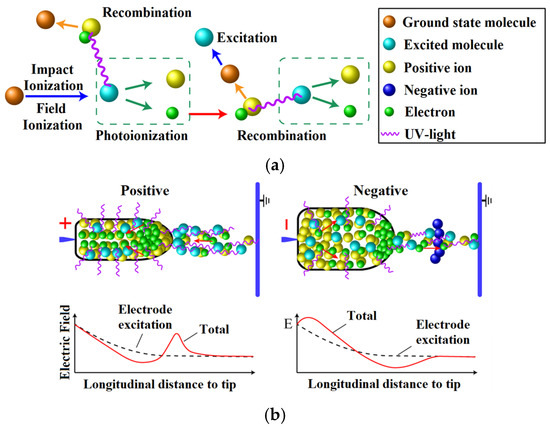
Figure 10.
Photoionization model of streamer in natural ester insulating oil under inhomogeneous electric field. (a) Schematic diagram of photoionization of streams in natural ester insulating oil. (b) Schematic diagram of photoionization principles for positive and negative streamers.
4. Conclusions
In this study, we employed UV absorber to regulate the photoionization behavior of streamer discharges in rapeseed insulating oil. A quantitative assessment was conducted on the propagation morphology, length, and temperature distribution of positive and negative streamers, providing guidance for enhancing the insulating performance of natural ester insulating oils. The main conclusions are as follows:
- (1)
- Photoionization promotes the rapid axial propagation of streamer branches along the needle-plate electrode. Photoionization can generate charges in both the internal and external regions of the streamer branches. When photoionization is suppressed, more local high-temperature hotspots appear in the internal region of the streamer branches. Under the influence of high temperatures, the streamer is prone to developing more radial branches. Suppressing photoionization weakens the trend of rapid axial propagation of streamer branches, thereby effectively enhancing the lightning impulse breakdown voltage of natural ester insulating oils.
- (2)
- In positive polarity streamers, internal electrons migrate towards the needle electrode and concentrate in the axial region of the needle-plate electrode, which is conducive to the recombination of positive ions and the emission of intense UV light. The space charge at the head of the positive polarity streamer also enhances the electric field at the streamer head and promotes the excitation of more molecules in the region ahead of the streamer head to high energy levels, which is beneficial for subsequent photoionization. In contrast, in negative polarity streamers, internal electrons migrate towards the plate electrode and the outside of the streamer, and the dispersed electrons inside the streamer are not conducive to positive and negative charge recombination. The electric field at the head of the negative polarity streamer is weakened due to the accumulation of negative ion space charges, which is not conducive to the excitation of molecules in the region ahead of the streamer and subsequent photoionization.
This work primarily analyzes the evolution patterns of luminous channels in positive and negative polarity streamers at the macroscopic level and the influence of photoionization on streamer branching. Future research will delve into the effects of ionization energy, excited states, and other microscopic electron structural parameters on photoionization.
Author Contributions
Conceptualization, Y.Q. and Q.W.; methodology, Y.Q. and Q.W.; software, Y.Q. and Q.W.; validation, Y.Q. and Q.W.; formal analysis, Y.Q. and Q.W.; investigation, Y.Q. and Q.W.; resources, Y.Q. and Q.W.; data curation, Y.Q. and Q.W.; writing—original draft preparation, Y.Q. and Q.W.; writing—review and editing, Y.Q. and Q.W.; visualization, Y.Q. and Q.W.; supervision, Y.Q. and Q.W.; project administration, Y.Q. and Q.W.; funding acquisition, Y.Q. and Q.W. All authors have read and agreed to the published version of the manuscript.
Funding
The research was funded by the China Southern Power Grid Co., Ltd. (GDKJXM20210086).
Data Availability Statement
The data presented in this study are available on request from the corresponding author due to confidentiality of wind power data.
Conflicts of Interest
Authors Yihua Qian and Qing Wang were employed by the company Electric Power Research Institute of Guangdong Power Grid Co., Ltd. The authors declare that the research was conducted in the absence of any commercial or financial relationships that could be construed as a potential conflict of interest.
Correction Statement
This article has been republished with a minor correction to the Funding statement. This change does not affect the scientific content of the article.
References
- Shen, Z.; Wang, F.; Wang, Z.; Li, J. A Critical Review of Plant-Based Insulating Fluids for Transformer: 30-Year Development. Renew. Sustain. Energy Rev. 2021, 141, 110783. [Google Scholar] [CrossRef]
- Rao, U.M.; Fofana, I.; Beroual, A.; Rozga, P.; Pompili, M.; Calcara, L.; Rapp, K.J. A Review on Pre-Breakdown Phenomena in Ester Fluids: Prepared by the International Study Group of IEEE DEIS Liquid Dielectrics Technical Committee. IEEE Trans. Dielectr. Electr. Insul. 2020, 27, 1546–1560. [Google Scholar] [CrossRef]
- Rozga, P.; Beroual, A.; Przybylek, P.; Jaroszewski, M.; Strzelecki, K. A Review on Synthetic Ester Liquids for Transformer Applications. Energies 2020, 13, 6429. [Google Scholar] [CrossRef]
- Li, S.; Wang, F.; Ouyang, L.; Chen, X.; Yang, Z.; Rozga, P.; Li, J.; Fofana, I. Differential Low-Temperature AC Breakdown between Synthetic Ester and Mineral Oils: Insights from Both Molecular Dynamics and Quantum Mechanics. IEEE Trans. Dielectr. Electr. Insul. 2024, 31, 1296–1304. [Google Scholar] [CrossRef]
- Lyutikova, M.; Korobeynikov, S.; Mohan Rao, U.; Fofana, I. Mixed Insulating Liquids with Mineral Oil for High Voltage Transformer Applications: A Review. IEEE Trans. Dielectr. Electr. Insul. 2022, 29, 454–461. [Google Scholar] [CrossRef]
- Zhao, Y.; Qian, Y.; Zhang, Y.; Pan, S.; Li, Z.; He, Y. Evaluation of anti-oxidative properties of natural esters by HPLC and GC-MS. In Proceedings of the ICHVE 2022 conference, Chongqing, China, 25–29 September 2022. [Google Scholar]
- Shen, S.; Liu, Q.; Wang, Z. Shockwave Characteristics of Streamer Propagation in Insulating Liquids under Positive Lightning Impulse. IEEE Trans. Dielectr. Electr. Insul. 2021, 28, 493–501. [Google Scholar] [CrossRef]
- Li, S.; Wang, F.; Wang, Q.; Ouyang, L.; Chen, X.; Li, J. Numerical Modeling of Branching-Streamer Propagation in Ester-Based Insulating Oil under Positive Lightning Impulse Voltage: Effects from Needle Curvature Radius. IEEE Trans. Dielectr. Electr. Insul. 2023, 30, 139–147. [Google Scholar] [CrossRef]
- Lesaint, O. Prebreakdown Phenomena in Liquids: Propagation ‘Modes’ and Basic Physical Properties. J. Phys. D Appl. Phys. 2016, 49, 144001. [Google Scholar] [CrossRef]
- Liang, S.; Li, J.; Chen, L.; Wang, F.; Lin, X.; Wang, Y. Measurement and Influence Factor Analysis of Ion Mobility of Vegetable Insulation Oil. In Proceedings of the 2017 IEEE 19th International Conference on Dielectric Liquids (ICDL), Manchester, UK, 25–29 June 2017; IEEE: Piscataway, NJ, USA, 2017. [Google Scholar]
- Babaeva, N.Y.; Kushner, M.J. Effect of Inhomogeneities on Streamer Propagation: I. Intersection with Isolated Bubbles and Particles. Plasma Sources Sci. Technol. 2009, 18, 035009. [Google Scholar] [CrossRef]
- Jadidian, J.; Zahn, M.; Lavesson, N.; Widlund, O.; Borg, K. Stochastic and Deterministic Causes of Streamer Branching in Liquid Dielectrics. J. Appl. Phys. 2013, 114, 063301. [Google Scholar] [CrossRef]
- Hao, J.; Dan, M.; Liao, R.; Li, J. Effect of Moisture on Particles Accumulation and Oil Breakdown Characteristics in Mineral Oil and Natural Ester under Non-Uniform DC Electrical Field. IEEE Access 2019, 7, 101785–101794. [Google Scholar] [CrossRef]
- Ingebrigtsen, S.; Lundgaard, L.E.; Åstrand, P.-O. Effects of Additives on Prebreakdown Phenomena in Liquid Cyclohexane: II. Streamer Propagation. J. Phys. D Appl. Phys. 2007, 40, 5624–5634. [Google Scholar] [CrossRef]
- Ingebrigtsen, S.; Smalo, H.S.; Astrand, P.-O.; Lundgaard, L.E. Effects of Electron-Attaching and eEectron-Releasing Additives on Streamers in Liquid Cyclohexane. IEEE Trans. Dielectr. Electr. Insul. 2009, 16, 1524–1535. [Google Scholar] [CrossRef]
- Wang, K.; Wang, F.; Lou, Z.; Han, Q.; Zhao, Q.; Hu, K.; Huang, Z.; Li, J. Relationship between the Electrical Characteristics of Molecules and Fast Streamers in Ester Insulation Oil. Int. J. Mol. Sci. 2020, 21, 974. [Google Scholar] [CrossRef]
- Sun, A.; Huo, C.; Zhuang, J. Formation Mechanism of Streamer Discharges in Liquids: A Review. High Volt. 2016, 1, 74–80. [Google Scholar] [CrossRef]
- Madshaven, I.; Hestad, O.L.; Unge, M.; Hjortstam, O.; Åstrand, P.O. Photoionization Model for Streamer Propagation Mode Change in Simulation Model for Streamers in Dielectric Liquids. Plasma Res. Express 2020, 2, 015002. [Google Scholar] [CrossRef]
- Madshaven, I.; Smalo, H.S.; Unge, M.; Hestad, O.L. Photoionization Model for the Transition to Fast Mode Streamers in Dielectric Liquids. In Proceedings of the IEEE Conference on Electrical Insulation and Dielectric Phenomena (CEIDP), Toronto, ON, Canada, 16–19 October 2016; IEEE: Piscataway, NJ, USA, 2016. [Google Scholar]
- Liang, S.; Wang, F.; Huang, Z.; Chen, W.; Wang, Y.; Li, J. Significantly Improved Electrical Breakdown Strength of Natural Ester Liquid Dielectrics by Doping Ultraviolet Absorbing Molecules. IEEE Access 2019, 7, 73448–73454. [Google Scholar] [CrossRef]
- Li, X.; Wang, F.; Wang, K.; Huang, Z.; Wang, Q.; Li, C.; Long, Y.; Pan, J.; Li, J. Numerical Evaluation on the Propagation of Non-Breakdown Streamer in Natural Ester under Negative Lightning Impulse Voltage via Shadowgraph Imaging. IEEE Trans. Dielectr. Electr. Insul. 2021, 28, 1198–1206. [Google Scholar] [CrossRef]
- IEC60897; Methods for the Determination of the Lightning Breakdown Voltage of Insulating Liquids. IEC: Geneva, Switzerland, 1987.
- Hwang, J.G.; Zahn, M.; Pettersson, L.A.A. Mechanisms behind Positive Streamers and Their Distinct Propagation Modes in Transformer Oil. IEEE Trans. Dielectr. Electr. Insul. 2012, 19, 162–174. [Google Scholar] [CrossRef]
Disclaimer/Publisher’s Note: The statements, opinions and data contained in all publications are solely those of the individual author(s) and contributor(s) and not of MDPI and/or the editor(s). MDPI and/or the editor(s) disclaim responsibility for any injury to people or property resulting from any ideas, methods, instructions or products referred to in the content. |
© 2025 by the authors. Licensee MDPI, Basel, Switzerland. This article is an open access article distributed under the terms and conditions of the Creative Commons Attribution (CC BY) license (https://creativecommons.org/licenses/by/4.0/).